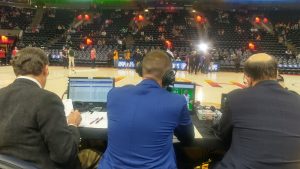14 Sports
It seems like half of the people who watch sports regularly, dream of being a sportscaster some day. Unfortunately, the odds of them making it to the big time are about the same as a kid hoping to make the big leagues in his or her given sport. There are jobs in sports casting but the market is as competitive as the sports it covers.
That being said, it can be done. The ESPN layoffs of 2017 showed that budgets are not endless, but local sports reporters and anchors continue to do their jobs day after day, bringing their viewers the highlights and profiles of their local and national sports teams.
Sports departments are usually in their own corner of the newsroom. Sports anchors coordinate with producers, especially for time allotments, and the assignment desk for photographers, but basically do their own thing. Sports reporters may have to shoot their own video even in markets where reporters don’t. Large markets may have dedicated sports photographers but they’re getting harder to come by.
Sports Writing Rules
Sports’ style is different from news. Sports reporters get more latitude and often can ad-lib and use sentence fragments more. But they must follow Rule #1 even more than news: It is tough to imagine video of a batter running the bases as the sportscaster tells you he has just hit a home run; you must show that batter hitting the ball and the ball clearing the fence. Early in my career I was shooting the Minor League series for my station’s hometown team. The series was tied. Our team was down in the ninth inning with runners on base. The batter swung hard and the ball that would win the series was headed over the fence. I lost it as it sailed away. Our sports anchor showed me a lot less frustration than he must’ve felt inside. He was stuck describing the play to viewers.
Sports reporting must still tell a story with a beginning, middle and ending. When you shoot a feature of the rising star on the basketball team, find a starting point, introduce conflict — if they haven’t overcome something than there is no point being there — and then tell how they have overcome. Perhaps the conflict comes at the end when the athlete heads off to the competition. Tip: If you want to do a story about how great an athlete is, don’t ask them about their talents and skills, ask their teammates.
The rest of your writing tips come from experienced sports anchors:
From Wes Ruff, KTVX Sports Director since 2002:
As far as television sports writing is concerned, I believe that it is more conversational than regular news writing. It’s almost like having a conversation with a friend and you’re telling him about a game you watched. You obviously need to get the who, what, where, when and why into the script, but you can do so in a manner that is more like you’re just talking to a buddy.
And because sports time is usually short in a newscast, the writing needs to be tight and concise. Don’t use 10 words when six will do. That’s probably why the typical sportscaster sometimes leaves out words. For instance, its not uncommon to hear “Big game tonight at the arena” as opposed to a more grammatically correct version “There was a big game tonight at the arena.” I’m not encouraging that, I’m just pointing out that is more the norm than the exception.
As a rule, sports writing includes more adverbs and adjectives than news writing. You’re trying to get the viewer excited about a game or the highlights. If you’re not excited about it, why would the viewer be excited? So phrases like “big game,” “incredible comeback,” “amazing effort,” are more prevalent in sports writing than news writing. Tell the story, get the facts straight and make sure the viewer can feel the excitement you felt from watching the game in person.
From Jeremiah Jensen, sports anchor and reporter at KSL since 2005:
Less is more when it comes to writing copy in sports broadcasting. We have a limited amount of time to communicate to our audience. It’s important not to get too wordy or too descriptive. Make your writing conversational. Make it something your audience will understand and relate to. Talk to your audience the way you would talk to friends or family. Make it conversational.
Another problem some TV sports anchors fall into is doing play by play over highlights. We forget that our audience can see the video highlights we are showing. They don’t need us to describe what they are seeing. This isn’t radio or print. What the audience does want from us is to tell them something about what we are seeing that they can’t see. That can be an important stat, a fact about an athlete or explaining what kind of play the team is running. We can give the viewer so much more value in our sportscasts by digging deeper and delivering information or a point of view that the viewer may not see or know. That can be the difference in having viewers come back again and again to watch your sportscasts, or look elsewhere.
Jim Crandell, Sports Director at KTXL since 1992:
I am probably not the best person to ask about writing, considering I write almost nothing. I put my story slugs in the rundown/prompter but that’s usually about it. I may have a few notes in the prompter, especially stats, but I ad-lib my shows. That said…
Don’t try too hard to be clever or funny. If something comes naturally and it feels comfortable, go with it. However, if you have to sit at a keyboard trying to think of something catchy, your final product will most likely seem forced, or worse, trite. Along that line, don’t use the first thing you think of, especially if it’s play on words, a pun, etc. If it’s the first thing that came to you, almost everyone else, including other sports reporters, probably thought the same thing. Give your viewers a good, solid, factually correct, well-reported story with some energy. That is what they expect. They can get plenty of comedy after the news from Jimmy Fallon.
That philosophy applies to writing PKGs, VOs and anchoring sports segments. I sometimes feel ESPN’s two anchor sports segments are not so much about information and highlights as they are about the two personalities at the desk. The shows degenerate into “I’m funnier than you are. Listen to this.” My number one suggestion for anchoring is to write as little as possible. Talk to your viewers like one sports lover to another, and you don’t need copy for that. You will need to work with the director so he knows your cues to roll video, etc., but if you can ad-lib most of your show, you will make an impression.
Access
Professional sports teams, even though they’re named after your town and play in stadiums taxpayers help pay for, are private businesses. Most are happy to allow accredited news media in for games (and feed them!) and some practices, but that could be cut off at any time.
Public universities can limit your access to practice and even some games. Private universities can limit any access they wish. Access was better before the Internet, web reporters and tweeters, but some privileged-access conversations and plays were published. Access gets limited a little more every time someone does this.
A player can choose whether he talks to you or not. When you’re sent into a losing locker room, have some tact in how you ask your questions. If the athlete knows you are fair and respectful, you shouldn’t have problems getting future interviews.
Dress
Going into locker rooms brings up proper dress for the job. When I head out to cover a game, I find out the colors of both teams and dress in neither. We are not cheerleaders, we are neutral reporters who document the good and bad for both teams equally. This should be apparent in your writing, too.



